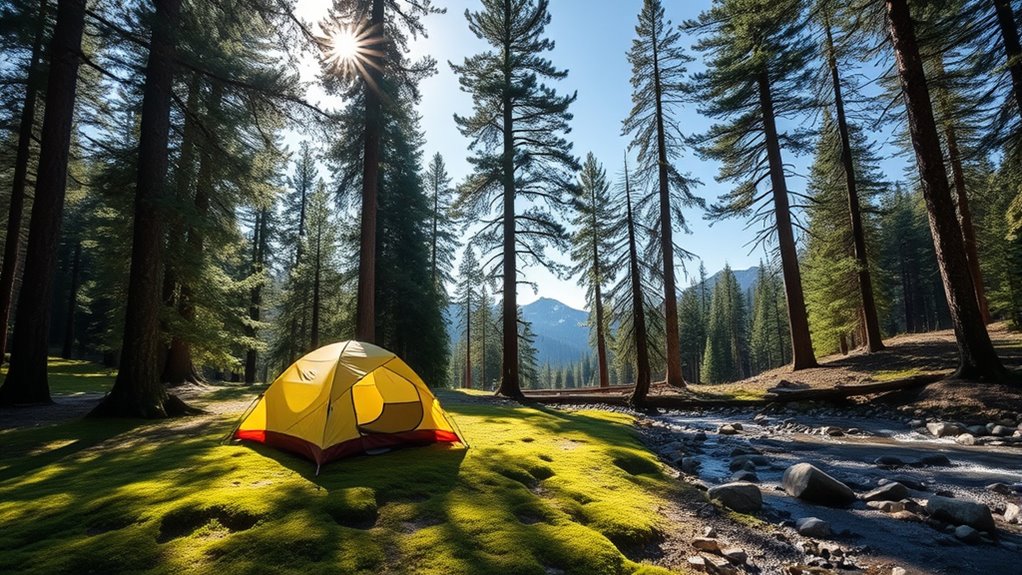When picking a campsite, focus on finding a quiet spot away from busy trails or noisy areas to enjoy peace and avoid disturbing wildlife. Seek natural windbreaks like dense trees or rocks to shield against gusts and prevent hazards. Make sure the site is easily accessible but not too close to roads or water sources that could attract animals or cause flooding. For more tips on balancing safety and comfort, keep exploring how to choose the ideal spot for your outdoor adventure.
Key Takeaways
- Select a quiet, natural environment away from busy trails and crowds to minimize noise and wildlife disturbance.
- Seek windbreaks like dense trees or natural formations to protect against strong gusts and maintain safety.
- Choose accessible sites with clear pathways that balance ease of access and safety, avoiding risky terrain.
- Avoid flood-prone or unstable areas by assessing terrain and natural barriers for environmental safety.
- Balance safety and comfort by prioritizing noise reduction, wind protection, and easy access during site selection.

Finding the right campsite is essential for a safe and enjoyable outdoor experience. When you choose your spot, consider how noise, wind, and access will affect your stay. These factors can substantially influence your comfort and safety, especially when it comes to wildlife encounters. A quiet site away from busy trails or crowded areas helps minimize unexpected wildlife visits, reducing the risk of dangerous encounters. Plus, a peaceful environment allows you to relax and enjoy nature without constant disturbance. Remember, loud noises or sudden movements can attract animals or scare them into aggressive behavior, so selecting a spot with natural barriers or distance from animal paths boosts campsite safety. Additionally, choosing a site with appropriate terrain can prevent issues like flooding or erosion, contributing to a safer camping experience.
Wind is another critical element in choosing your location. Strong gusts can cause trees or branches to fall, posing a hazard to your campsite. Look for areas with windbreaks like dense trees, shrubs, or natural rock formations that can shield you from strong gusts. Avoid open, exposed spaces, especially on ridges or hilltops, where wind speeds tend to be higher. Proper placement not only keeps you comfortable but also prevents damage to your gear and helps maintain a safe environment. Additionally, wind can carry animal scents or sounds, influencing wildlife activity around your campsite. Being mindful of prevailing wind directions can help you avoid attracting unwanted wildlife or disturbing nearby animals, further enhancing campsite safety.
Access also plays a crucial role in selecting your camping location. You want a spot that’s easily reachable but not so close to busy roads or heavily trafficked paths that noise and disturbance become issues. Adequate access ensures you can bring in your gear efficiently and evacuate quickly if needed. Consider proximity to water sources, but avoid setting up directly next to streams or lakes, as these areas tend to attract wildlife more frequently. Proper access also means choosing a site with clear pathways that don’t require risky climbing or traversing difficult terrain, which could cause injuries or delays during emergencies.
Ultimately, your goal is to find a balance among these factors that aligns with your safety and comfort preferences. Prioritize sites that offer natural buffers from noise, wind protection, and straightforward access. Doing so not only enhances your outdoor experience but also ensures you’re prepared for any wildlife encounters that might occur. When you stay attentive to these details, you create a safer, more enjoyable environment where nature’s beauty can be appreciated without unnecessary risk.
Frequently Asked Questions
How Does Seasonal Weather Affect Campsite Noise Levels?
Seasonal weather considerably impacts campsite noise levels through changing weather patterns. During peak seasons, noise tends to increase due to more visitors and outdoor activities, while off-season, you’ll notice quieter surroundings. Windy seasons might amplify natural sounds, making noise seem louder, whereas calmer weather reduces ambient noise. You can plan better by considering these seasonal variations, choosing times when weather patterns create a more peaceful environment, enhancing your camping experience.
What Are the Best Strategies to Minimize Wind Impact?
Ironically, fighting the wind is easier than it sounds. You should check the wind direction first—set up your tent so it faces away from the breeze. Use natural shelter options like trees or rocks for protection. If you need extra shielding, bring tarps or windbreaks. By strategically positioning your campsite and using shelter options, you minimize wind impact, ensuring a more comfortable and peaceful outdoor experience.
How Can I Assess Campsite Access During Adverse Weather?
You should check weather forecasts before heading out and look for alternative camping spots with better access during adverse weather. Consider terrain features like natural barriers that can shield you from wind and rain, ensuring safety and comfort. Opt for sites with scenic views that are still accessible, and avoid low-lying areas prone to flooding. Good planning helps you stay dry and enjoy your trip despite challenging weather conditions.
Are There Specific Locations Better Suited for Certain Noise Sensitivities?
If you’re sensitive to noise, look for soundproof zones or quiet areas within the campsite. These spots are often tucked away from busy paths or communal areas, giving you a break from the hustle and bustle. To find such locations, ask park staff or scout out natural features like dense trees or hills that buffer sound. By doing your homework, you can enjoy peace and quiet, no matter your noise sensitivities.
How Do Nearby Roads Influence Campsite Noise and Accessibility?
Nearby roads can considerably impact your campsite by increasing noise levels, especially if you’re close to major access points. Proximity to roads might also make access easier, but it can lead to more traffic and disturbances. To find a peaceful spot, choose sites farther from busy access points and consider how road proximity affects both your tranquility and convenience during your stay.
Conclusion
By considering noise levels, wind exposure, and access points, you guarantee a comfortable camping experience. For example, Sarah once chose a spot near a creek, but strong winds and constant noise from nearby wildlife made her stay uncomfortable. Learning from her, you’ll prioritize quieter, sheltered locations with easy access. Taking these factors into account allows you to enjoy nature peacefully and safely, making every camping trip more enjoyable and memorable.










